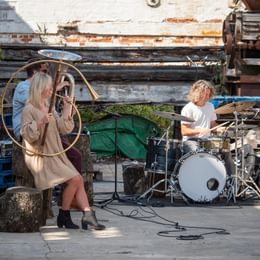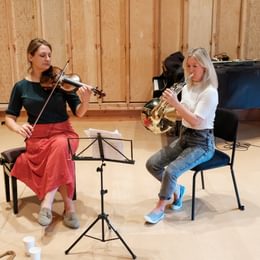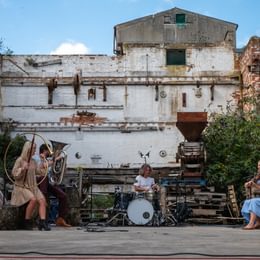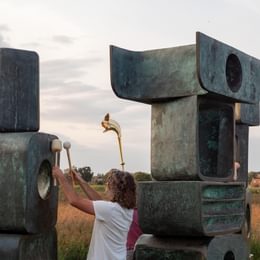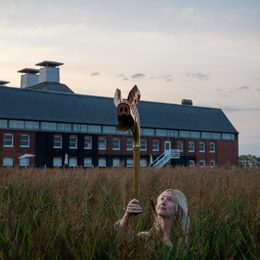Participants | Letty Stott, Ed Ashby, Alice Zawadzki, Luke Christie
Taking ancient forms of horn from Etruscan, Greek and Roman civilisations, this project explores the visual and sonic possibilities of these striking instruments and asks the question of what their role in a modern world might be. Drawing upon their fascinating history, an entirely new sound world emerges through a collaboration between brass, percussion, violin and voice.
Between 680 BCE and 400 CE, several brass instruments with hugely important ritual and cultural functions were developed by Etruscan, Native European and Ancient Greek societies. These instruments were visually stunning, combining extraordinary craftsmanship with complex social meaning. This project explores the historical background of four of these instruments (Karnyx, Salpinx, Lituus and Cornu) and asks the question of what these horns might bring to a modern age, both historically and musically.
The instruments themselves are extremely well-researched analogues of horns recovered from archaeological finds, made by Dr Peter Holmes who has generously loaned them for this project. Performed by Letty Stott, Ancient Horns places these unique instruments in a modern-day context through a musical collaboration with Alice Zawadzki (violin and voice), Ed Ashby (tuba) and Luke Christie (percussion).
In these uncertain times for the arts, perhaps it is of value to look back to the past to see what can be learnt and to listen to these ancient instruments, which call from a distant world.
Instruments generously loaned for this project by Dr Peter Holmes.
Letty is one of the UK’s most exciting and versatile horn players, with her career spanning across a wide variety of genres. As a classical French horn player, Letty has worked with many of the UK’s leading orchestras and opera companies (including the Royal Philharmonic Orchestra, Britten Sinfonia, English National Opera and the Royal Opera House) and has performed with a huge variety of commercial artists. She has recorded as a session musician for TV and film and has performed and toured globally.
Letty has considerable experience working in theatre and performed onstage for the highly-acclaimed production of Amadeus at the National Theatre, broadcast to cinemas worldwide as part of NT Live. She was also part of the National Theatre’s Macbeth, working with composer Orlando Gough and instrument builder Simon Allen to create new instruments especially for the production. Letty has worked with Poet Laureate Simon Armitage on production of Hansel and Gretel and has performed with the Royal Shakespeare Company (Julius Caesar) and for shows including Disney’s Lion King. Letty is a member of Perhaps Contraption band, who have played at Glastonbury, Edinburgh Festival (to premiere their theatre show Nearly Human), London Jazz Festival and the Süd-Tirol Jazz Festival.
Image gallery
Ancient Horns
Cornu
The Etruscan Cornu is the instrument most similar to my modern French horn in terms of how it both looks and plays. As a simple, elegant circle of metal, the Cornu has as its available pitches many of the notes of the harmonic series that could be found on a natural horn today. Appropriated by the Romans from its Etruscan origins, the Cornu was used throughout the Empire in a military capacity, with two cornicenes (horn-blowers) blowing their horns as the army marched. The Cornu (originating from around 79 CE, as Mount Vesuvius was about to erupt) was also used in Roman society, sometimes paired in combination with the Lituus (often linked to magisterial processions) and occasionally played at Chariot races, where the cornicen would blow their horn to encourage the charioteers and their horses in a final lap of the amphitheatre.
It is this image that we have tried to evoke in Chariots – the excitement of the race, the crowds surging forward at the last lap and the sense of euphoria for the winner as they raced to the finish.
Lituus
The Etruscan Lituus is perhaps the most mysterious and enigmatic of all of the horns and it is this character which appeals to me the most. With only six Litui ever discovered in archeological digs, it is the oldest of the ancient horns in this project, dating back to around 680 BCE. The specific Lituus used in this project (generously loaned by its maker, Dr Peter Holmes), is a modern-day analogue of the Pian di Civita Lituus, excavated from the ancient city of Tarquinia. The Lituus was not discovered in its present-day form, however, but had been ritually bent into three sections so that it could no longer be used as a sound tool. The instrument was then buried in a shallow pit under the threshold of a ritual building along with an axe, a folded shield and the body of a young child, ensuring that anyone who entered would have to pass over this liminal space. The power of this instrument therefore outlasted its worldly use and it is this that fascinates me about the ethereal Lituus.
Played with the bell on the ground, the Lituus forms a conduit between worlds and the spiral cord around the tubing could be said to represent a snake, in itself a symbol of immortality and rebirth. In Roman society, the J-shaped Lituus existed in two forms, that of sound tool and then also as the ritual staff of an augur, raised up to the sky to make a square and to see into the future.To me, this instrument is the most fascinating of the horns, offering so many possible interpretations but by no means giving away its secrets.
Karnyx
The Karnyx is by far the most striking of the ancient horns, with its boar-like head and giant height when in playing position deliberately used in battle to terrify the opposition. Dating back to around 200 CE, there have been examples of Karnyces found across Europe, with one of the most spectacular find-spots in Tintignac, France, where fragments of seven karnyces were found, along with over 500 bronze artefacts.
Most Karnyces possess zoomorphic features wrought from precious metals – some have the head of a snake, others the tongue, teeth, ears and crest of a wild boar and all have eyes that stare out. Karnyces certainly made a lasting impression on the Romans, who decorated coins with their image and used them in tropaei flaunting their victory over the vicious tribes they had finally subjugated. Caesar himself reported that Vercingetorix signalled to his troops using war-horns and it is this wild battle-cry that we have tried to channel, of native peoples fighting for their freedom against the inevitable Roman conquest.
Salpinx
The Salpinx was a hugely powerful instrument in Ancient Greece. Used throughout Greek society, the Salpinx was an instrument of justice, summoning criminals who had committed a capital offence to court. It had its own category at the Olympic Games (quite possibly for the player who could make the loudest noise for the longest time, as it is certainly an instrument capable of great volume!). Whilst not very complimentary about the instrument, Pollux (second century CE), says that it is ‘ shrill’, ‘booming’, ‘strong’, ‘violent’, ‘horrible’, ‘disordered’, and ‘warlike’…
Indeed, players of the instrument (known as ‘Salpinktai’) were often said to be of large stature, with rather enormous appetites. However, the Salpinx was not just associated with male players and one of the first ever recorded Salpinktes was Aglaïs, daughter of Megakleous. According to several authors, she took part in an inaugural procession in Alexandria in 275 BCE, as described by Poseidipus:
“I hear that a woman played the trumpet and that it was both her profession and her art. Her name was Aglais, daughter of Megaldes. She wore a toupee-shaped hairpiece on her head. Her meal consisted of twelve pounds of meat and four loaves of bread. She drank a large measure of wine.”
Other female Salpinktai included Nike, Goddess of Victory and Athena, Goddess of War. Athena is sometimes even called Athena Salpinx, so closely was she associated with the instrument, with her clear voice like the sound of a trumpet. One of my favourite tales is from Homer’s Iliad, when Athena calls with a Salpinx to Achilles to rouse his spirits when he has just discovered that his beloved Patroclus is dead. Achilles goes on to defeat the Trojans and it is to the powerful, just and wise Athena that this song is dedicated.

